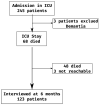Prognosis of Very Elderly Patients after Intensive Care
- PMID: 35207170
- PMCID: PMC8874469
- DOI: 10.3390/jcm11040897
Prognosis of Very Elderly Patients after Intensive Care
Abstract
Elderly patients (over age 85) are increasingly treated in Intensive Care Units (ICU), despite doctors' reluctance to accept these frail patients. There are only few studies describing the relevance of treatments for this group of patients in ICU. One of these studies defined an age of 85 or over as the essential admittance criterion. Exclusion criteriwere low autonomy before admittance or an inability to answer the phone. Epidemiological data, history, lifestyle, and autonomy (ADL score of six items) were recorded during admission to the ICU and by phone interviews six months later. Eight French ICUs included 239 patients aged over 85. The most common diagnostics were non-cardiogenic lung disease (36%), severe sepsis/septic shock (29%), and acute pulmonary oedem (28%). Twenty-three percent of patients were dependent at the time of their admission. Seventy-one percent of patients were still alive when released from ICU, and 52% were still alive after 6 months. Among the patients which were non-dependent before hospitalization, 17% became dependent. The only prognostic criterifound were the SAPS II score on admission and the place of residence before admission (nursing home or family environment had poor prognosis). Although the prognosis of these elderly patients was good after hospitalization in ICU, it should be noted that the population was carefully selected as having few comorbidities or dependence. No triage critericould be suggested.
Keywords: ICU; autonomy score; dependency; very elderly patients.
Conflict of interest statement
The authors declare no conflict of interest.
Figures
Similar articles
-
Low sensitivity of qSOFA, SIRS criteria and sepsis definition to identify infected patients at risk of complication in the prehospital setting and at the emergency department triage.Scand J Trauma Resusc Emerg Med. 2017 Nov 3;25(1):108. doi: 10.1186/s13049-017-0449-y. Scand J Trauma Resusc Emerg Med. 2017. PMID: 29100549 Free PMC article.
-
Accuracy of a composite score using daily SAPS II and LOD scores for predicting hospital mortality in ICU patients hospitalized for more than 72 h.Intensive Care Med. 2001 Jun;27(6):1012-21. doi: 10.1007/s001340100961. Intensive Care Med. 2001. PMID: 11497133
-
Triage of Septic Patients Using qSOFA Criteria at the SAMU Regulation: A Retrospective Analysis.Prehosp Emerg Care. 2018 Jan-Feb;22(1):84-90. doi: 10.1080/10903127.2017.1347733. Epub 2017 Aug 9. Prehosp Emerg Care. 2018. PMID: 28792256
-
[Predictive value of glycemic variability within 6 hours on the short-term prognosis of patients with septic shock].Zhonghua Wei Zhong Bing Ji Jiu Yi Xue. 2021 Jan;33(1):28-32. doi: 10.3760/cma.j.cn121430-20200410-00274. Zhonghua Wei Zhong Bing Ji Jiu Yi Xue. 2021. PMID: 33565396 Chinese.
-
Outcome of patients with sepsis and septic shock after ICU treatment.Langenbecks Arch Surg. 1998 Mar;383(1):44-8. doi: 10.1007/s004230050090. Langenbecks Arch Surg. 1998. PMID: 9627170 Review.
Cited by
-
Elderly Patients and Management in Intensive Care Units (ICU): Clinical Challenges.Clin Interv Aging. 2023 Jan 22;18:93-112. doi: 10.2147/CIA.S365968. eCollection 2023. Clin Interv Aging. 2023. PMID: 36714685 Free PMC article. Review.
-
Clinical characteristics and outcome of very old (≥90 years) critically ill patients with need for intensive care after surgical intervention.Front Med (Lausanne). 2025 May 9;12:1509337. doi: 10.3389/fmed.2025.1509337. eCollection 2025. Front Med (Lausanne). 2025. PMID: 40417683 Free PMC article.
References
-
- INSEE . Série 001641607 Démographie—Population au début du mois—France (Inclus Mayotte Partir de 2014) Insee; Paris, France: 2016.
LinkOut - more resources
Full Text Sources




